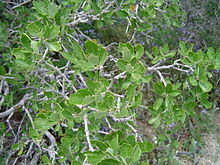Quercus berberidifolia
| Quercus berberidifolia | |
|---|---|

| |
| Scientific classification | |
| Kingdom: | |
| (unranked): | |
| (unranked): | |
| (unranked): | |
| Order: | |
| Family: | |
| Genus: | |
| Section: | |
| Species: | Q. berberidifolia
|
| Binomial name | |
| Quercus berberidifolia Liebm. 1854
| |
| Synonyms[1] | |
| |
Quercus berberidifolia, the California scrub oak, is a small evergreen or semi-evergreen shrubby oak in the white oak section of Quercus. It is a native of the scrubby hills of California, and is a common member of chaparral ecosystems.[2]
Description
Quercus berberidifolia grows to 1–2 meters (40-80 inches) tall, rarely to 4 meters (160 inches)or 10 feet), and has sharply toothed, dull green leaves which are 1.5–3 cm (0.59–1.18 in) long and 1–2 cm (0.5–1 in) broad, leathery on their top surfaces and somewhat hairy underneath. The solitary or paired brown acorns are 1–3 cm (0.5–1 in) long and 1–2 cm (0.5–1 in) broad, and pointed or egg-shaped with thin caps when mature; they mature in about 6–8 months after pollination. In cooler, more exposed areas, scrub oak is usually a small, compact shrub, but in warm or sheltered areas the plant can spread out and grow several meters high.[3]
The epithet "berberidifolia" means "barberry-leaved," referring to the spiny leaf margins characteristic of Q. berberidifolia as well as of several species of Berberis.
Other species
Often known simply as scrub oak, though this name is also applied to other Quercus species, especially several which were formerly grouped under the single name Q. dumosa, all are found in scrubby habitats. Many other scrub-type oaks may be found in these regions, and careful inspection is required to identify individuals of Q. berberidifolia and its hybrids.
Quercus berberidifolia sometimes hybridizes with other species.
Chaparral origins
The word chaparral is derived from the Spanish word for scrub oak, chaparro. The non-specific meaning of the term is 'short in stature.' Because most scrub vegetation is rather low growing, the term is broadly applied to all of the vegetation in "chaparral" communities.
See also
References
External links
- Quercus
- Endemic flora of California
- Natural history of the California chaparral and woodlands
- Natural history of the California Coast Ranges
- Natural history of the Channel Islands of California
- Natural history of the Peninsular Ranges
- Natural history of the San Francisco Bay Area
- Natural history of the Santa Monica Mountains
- Natural history of the Transverse Ranges
- Plants described in 1854
- Bird food plants
- Garden plants of North America
